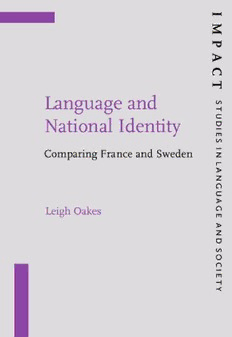
Language and National Identity: Comparing France and Sweden PDF
Preview Language and National Identity: Comparing France and Sweden
<ATSKSWVUIIDUEOZTIBYDOTEFLJWFHTECESHHCOOIEN"ETTRRLFI"aDG1O"n""5SIH4"gm0"uT">"pa"ga"ec2t2a01n"3d"NationalIdentity:ComparingFranceandSweden" LanguageandNationalIdentity Impact: Studies in language and society impactpublishesmonographs,collectivevolumes,andtextbooksontopicsin sociolinguisticsandlanguagepedagogy.Thescopeoftheseriesisbroad,with special emphasis on areas such as language planning and language policies; languageconflictandlanguagedeath;languagestandardsandlanguagechange; dialectology;diglossia;discoursestudies;languageandsocialidentity(gender, ethnicity,class,ideology);andhistoryandmethodsofsociolinguistics Generaleditor AnnickDeHouwer UniversityofAntwerp Advisoryboard UlrichAmmon WilliamLabov GerhardMercatorUniversity UniversityofPennsylvania LaurieBauer ElizabethLanza VictoriaUniversityofWellington UniversityofOslo JanBlommaert JosephLoBianco GhentUniversity TheAustralianNationalUniversity PaulDrew PeterNelde UniversityofYork CatholicUniversityBrussels AnnaEscobar DennisPreston UniversityofIllinoisatUrbana MichiganStateUniversity GuusExtra JeanineTreffers-Daller TilburgUniversity UniversityoftheWestofEngland MargaritaHidalgo VicWebb SanDiegoStateUniversity UniversityofPretoria RichardA.Hudson UniversityCollegeLondon Volume13 LanguageandNationalIdentity:ComparingFranceandSweden byLeighOakes Language and National Identity Comparing France and Sweden Leigh Oakes QueenMary,UniversityofLonden JohnBenjaminsPublishingCompany Amsterdam(cid:1)/(cid:1)Philadelphia TM ThepaperusedinthispublicationmeetstheminimumrequirementsofAmerican 8 NationalStandardforInformationSciences–PermanenceofPaperforPrinted LibraryMaterials,ansiz39.48-1984. LibraryofCongressCataloging-in-PublicationData Oakes,Leigh. Languageandnationalidentity:comparingFranceandSweden/ LeighOakes. p. cm.(Impact:Studiesinlanguageandsociety,issn1385–7908;v.13) Includesbibliographicalreferencesandindex. 1.Anthropologicallinguistics--France.2.Anthropologicallinguistics--Sweden.3. Ethnicity--France.4.Ethnicity--Sweden.5.Nationalism--France.6.Nationalism--Sweden. I.Title.II.Impact,studiesinlanguageandsociety;13. P35.5.F8 O18 2001 306.44’089--dc21 2001043496 isbn902721848(cid:3)X(Eur.)/158811116(cid:3)4(US)(Hb;alk.paper) ©2001–JohnBenjaminsB.V. Nopartofthisbookmaybereproducedinanyform,byprint,photoprint,microfilm,orany othermeans,withoutwrittenpermissionfromthepublisher. JohnBenjaminsPublishingCo.·P.O.Box36224·1020meAmsterdam·TheNetherlands JohnBenjaminsNorthAmerica·P.O.Box27519·Philadelphiapa19118-0519·usa Contents Preface vii Acknowledgements ix 1. Introduction 1 1.1 Aimsofthebook 3 1.2 Structureofthebook 5 2. Basicconcepts 9 2.1 Ethnicityandtheethnicgroup 9 2.2 Nationalismandthenation 11 2.3 Languageandlinguisticvariation 18 2.4 Language,ethnicityandnationalism 21 3. Theoreticalframework 29 3.1 Languageattitudes 29 3.2 Socialidentityandethnolinguisticidentitytheories 33 4. Languageandnationalidentity:Ageneralperspective 49 4.1 Linguisticconsciousness 49 4.2 LanguageandidentityinFrance:Ahistoricaloverview 53 4.3 LanguageandidentityinSweden:Ahistoricaloverview 64 4.4 FrenchandSwedishattitudestolanguagechangeand spellingreform 71 5. Languageandnationalidentityinthenationalarena 79 5.1 Ethnolinguisticminorities 79 5.2 LanguageandnationalidentityinFrance: Thenationalarena 88 5.3 LanguageandnationalidentityinSweden: Thenationalarena 104 5.4 FrenchandSwedishattitudestowardstheteaching ofminoritylanguagesandtheCharterforRegional orMinorityLanguages 116 vi Contents 6. LanguageandnationalidentityintheEuropeanarena 127 6.1 TheEuropeanarena:Anewculturalbattlefield? 127 6.2 English:TheEuropeanlinguafranca? 131 6.3 LanguageandidentityinFrance:TheEuropeanarena 136 6.4 LanguageandidentityinSweden:TheEuropeanarena 140 6.5 FranceandSwedenintheEuropeanarena:Futurechallenges 145 7. Languageandnationalidentityintheglobalarena 147 7.1 Anewglobalculture? 147 7.2 English:Agloballanguage? 149 7.3 LanguageandidentityinFrance:Theglobalarena 154 7.4 LanguageandidentityinSweden:Theglobalarena 163 7.5 FranceandSwedenintheglobalarena:Past andfuturechallenges 170 8. LanguageandnationalidentityinFranceandSweden:Asurvey 175 8.1 Aimsofsurvey 175 8.2 Methodology 177 8.3 Resultsandcomparativediscussionofthesurvey 185 9. Conclusion 229 9.1 Summaryoffindings 230 9.2 Futureresearch 235 Notes 239 AppendixA:QuestionnaireinFrench 249 AppendixB:QuestionnaireinSwedish 257 References 265 Indexofsubjects 293 Indexofnames 300 Preface Theaimofthisbookistore-examinetherelationshipbetweenlanguageand national identity. Unlike many previous studies, it employs a comparative approachforamorecomprehensiveunderstandingofthisrelationship.France and Sweden have been chosen as case studies both for their similarities (e.g. both are member states of the European Union) as well as their important differences (e.g. France, at least in principle, subscribes to a civic model of national identity, whereas the basis of Swedish identity is undeniably ethnic; language is so obviously a core value of French identity, but at first does not appear to be so for Swedish identity). It is precisely differences such as these whichallowforamorecompleteunderstandingoftheethnolinguisticimpli- cations of some of the major challenges currently facing France, Sweden and other European countries: regionalism, immigration, European integration andglobalisation. The present volume also differs from others on the market because of the variety of methods of inquiry used. Most previous studies of language and national identity are not reinforced by an empirical component, which adds weighttotheinvestigation.Thisistheaimofthesurvey,whichisthefocusof Chapter8. The book also uses a multidisciplinary approach that brings together materials from a range of fields (e.g. the sociology of language, sociolinguistics, socialpsychology, political science,history, economics) fora comprehensive examination of the role of language in national identity. Finally, it is worth noting that much of the French and especially Swedish literature reviewed in this book has traditionally been neglected by English- speaking researchers because of language barriers. All translations from foreign-languagesourcesarethoseoftheauthor,unlessotherwisespecified. The origins of this book lie in a Ph.D. dissertation completed at the UniversityofMelbourne,Australia,inAugust2000. Acknowledgements The research on which this book is based owes much to many people. First and foremost, I would like to thank my friend and former supervisor, Monique Monville-Burston. For ten years, Monique has been an invaluable source of inspiration and encouragement. Monique’s remarkable dedication and thoroughness will forever motivate me; in fact, so much of what I have alreadyachieved,Iowedirectlyorindirectlytoher.Forallthis,Icouldnever thankherenough. AnotherpersontowhomIamgreatlyindebtedisKennethHyltenstam,of the Centre for Research on Bilingualism at Stockholm University. Kenneth kindly accepted to supervise my work from September 1997 until December 1998, when the Swedish Institute generously offered me one of their guest scholarshipsforoverseasresearchers.IamverygratefultoothersattheCentre as well: to Maria Wingstedt, Barbro Allardt Ljunggren, Christopher Stroud, TaijaNyborg,AndersPhilipssonandVeliTuomela;inessence,toeveryoneat the Centre, I thank you so much for giving me a home, and for making me feelwelcome.IwillalwayshavefondmemoriesofmytimeinStockholm. MySwedishexperiencewasalsoshapedbytheassistanceofseveralothers: Mikael Svonni, Annick Sjögren, Margareta Westman, François Aillet, César Ibanez,AgnetaKarlsson,BirgittaLandströmandSivWiss.Therearemanyto thank in France too: Jean-François Baldi, Jean-François Battail, Maria Ridelberg-Lemoine,MonsieurCicaronne,MonsieurOlsem,MonsieurColpin, Monsieur Herlemont, Madame Rault, Madame Rebuffat, Philippe Audibert, Monsieur Rauch and Daniel Elduayen. From my time in Melbourne, I am indebtedtoJaneWarren,TimMcNamara,CatrinNorrbyandCathyElder;in London to Itesh Sachdev, Luc Bougniol-Laffont, Per Sörbom and to Richard Bourhis, whom I met on a trip of his to the UK. This book also greatly benefitedfromcommentsmadebyJohnEdwardsandDenisAger,theexam- inersofthedoctoraldissertationwhichprecededthiswork. At my new home, the School of Modern Languages at Queen Mary, UniversityofLondon,IamgratefultoJennyCheshire,JamalOuHallaandto mypredecessorHilaryWise,fromwhomIinheritedtheMAmoduleLanguage andNation,whichallowedmetodevelopfurthertheideasonwhichthiswork
